Watkins & Hill, Charing Cross, London
| DESCRIPTION | HISTORY |
Please Click On Any Picture for a Larger Version
the trade, before they settled on producing a number of the more succesful designs.
Watkins & Hill, Charing Cross, London. The microscope is supported by a solid brass tripod foot with a span of 190 mm. From this arises a 115 mm tall brass pillar which extends into a compass joint which can be tightened with a key. Its central portion carries the support for the stage which measures 95 x 100 mm, as well as the tubular limb, which extends into the tailpiece carrying a sleeve for the gimballed plano-concave mirror. The stage has a large central aperture, which is a bayonet fitting for the Bonanni spring stage. This can be removed for larger slides to be examined, held to the stage with a U-shaped clamp, which is affixed to the stage with two pins. A double-jointed arm is attached to the left-hand underside of the stage to carry the stage condenser. Under the stage is an exchangeable brass slider carrying a wheel of diaphragm stops. This can be exchanged for another slider with a rotating polarizer. Coarse adjustment is by rack-and-pinion, operated by a single large knurled knob and acting on a brass cylinder inside the limb. At its upper end, there is a push-fit tapered sleeve which takes the elegant
flying buttressarm carrying the 180 mm long body tube. This has an inner diameter of 32.2 mm to take the eye piece. There is no drawtube or fine adjustment.The lower portion of the optical tube carries a male thread of 13.1 mm external diameter to take the objectives which have a matching internal thread.
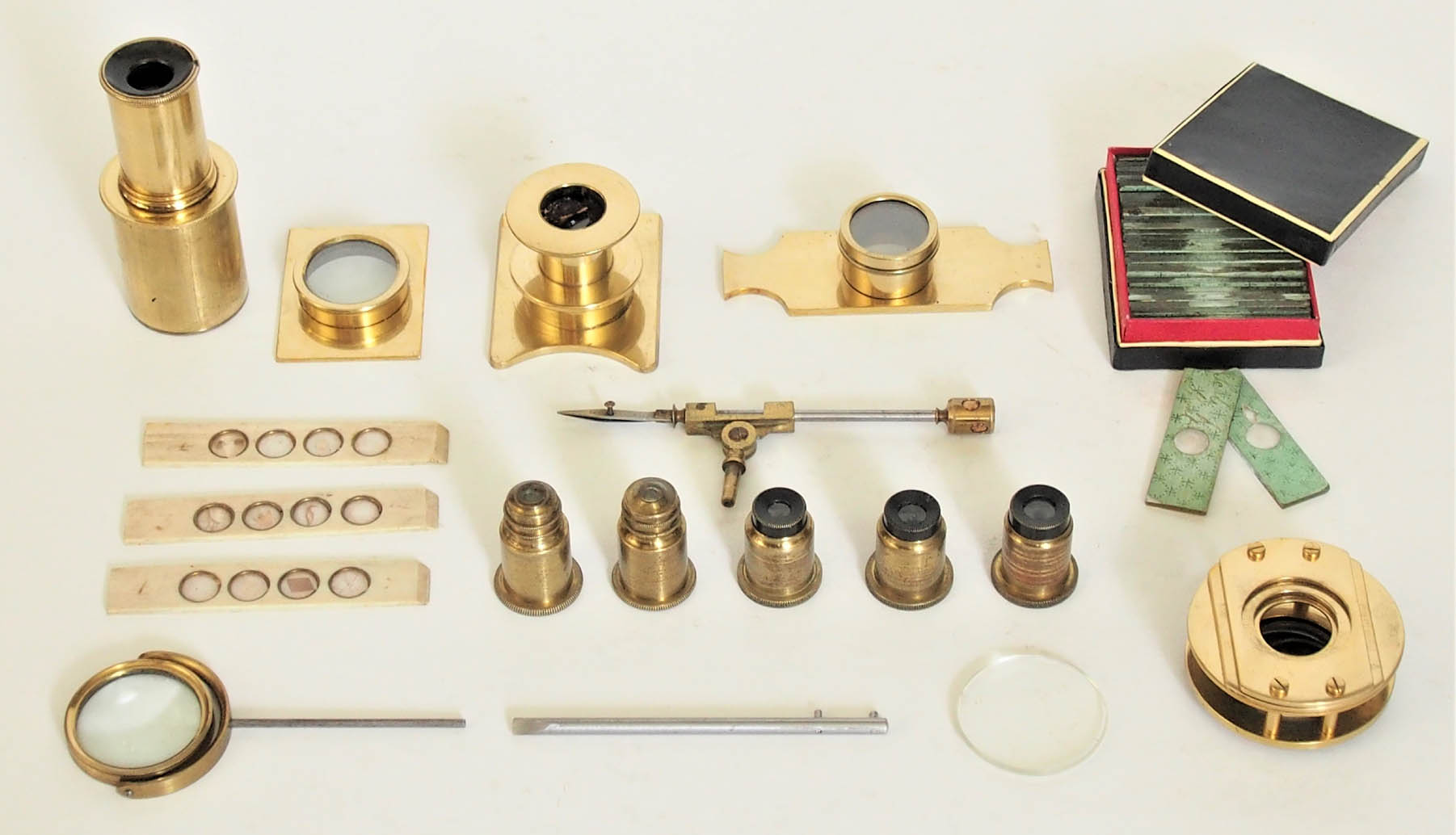
 There are 3 low-power non-achromatic objectives containing biconvex lenses in a screw mount. In addition, there are 2 achromatic combinations each made up of 2 achromatic
doublets, of which the back lens can be used alone, or in combination with its front lens.These are not exchangeable between the 2 objectives.
There are 3 low-power non-achromatic objectives containing biconvex lenses in a screw mount. In addition, there are 2 achromatic combinations each made up of 2 achromatic
doublets, of which the back lens can be used alone, or in combination with its front lens.These are not exchangeable between the 2 objectives.| OBJECTIVE WITH EYEPIECE | APPROX. N.A. | MAGNIFICATION WITH EYEPIECES | |
|---|---|---|---|
| Non-Achromatic 1 | 0.05 | 26 | |
| Non-achromatic 2 | 0.06 | 30 | |
| Non-achromatic 3 | 0.06 | 43 | |
| Achromatic 1 back | 0.19 | 80 | |
| Achromatic 1 back + front | 0.28 | 130 | |
| Achromatic 2 back | 0.11 | 56 | |
| Achromatic 2 back+ front | 0.34 | 175 | |
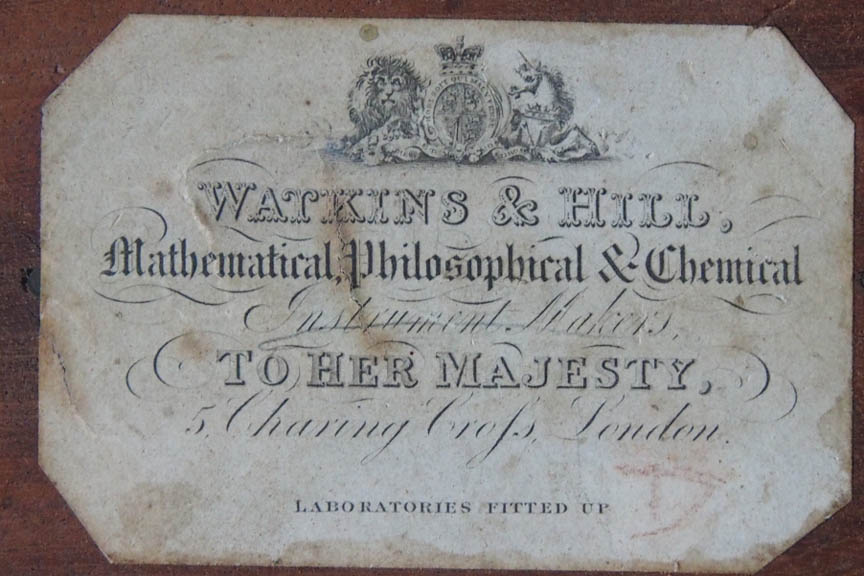 The microscope is stored in a disassembled state in its original solid mahogany case measuring 271 x 225 x 125 mm. Inside the lid is a trade label:
The microscope is stored in a disassembled state in its original solid mahogany case measuring 271 x 225 x 125 mm. Inside the lid is a trade label: Watkins & Hill, Mathematical, Philosophical & Chemical instrument makers to her majesty, 5 Charing Cross, London. Laboratories fitted up.
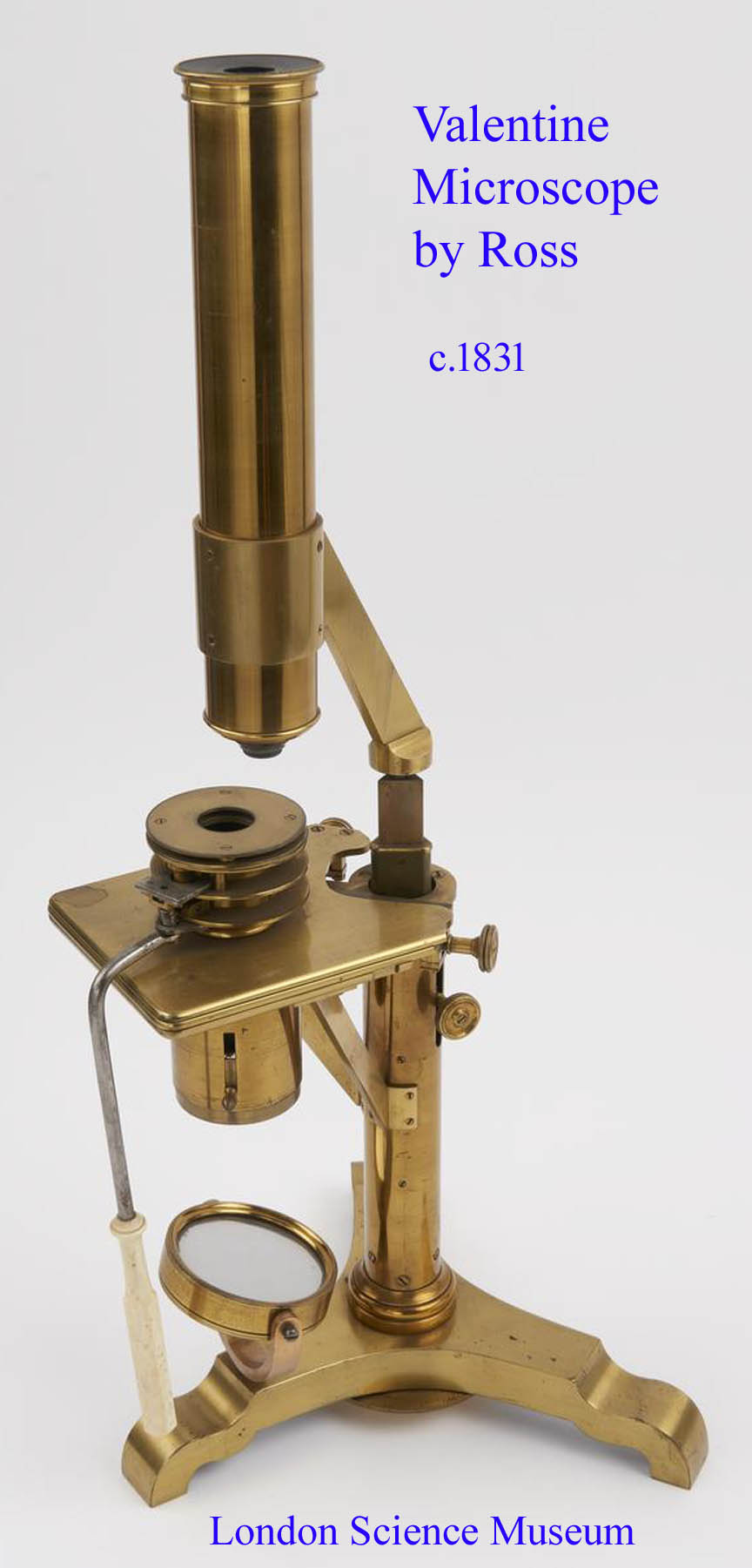
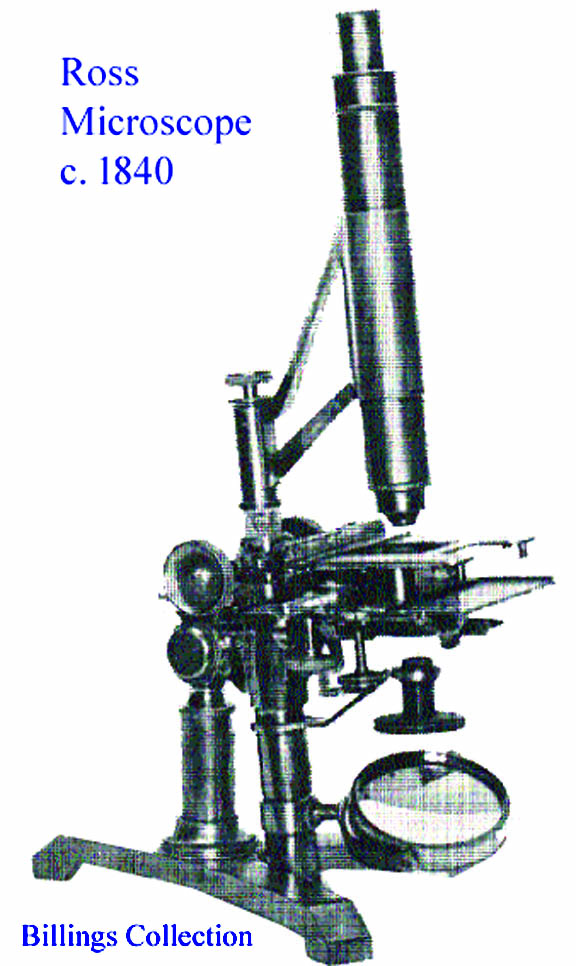
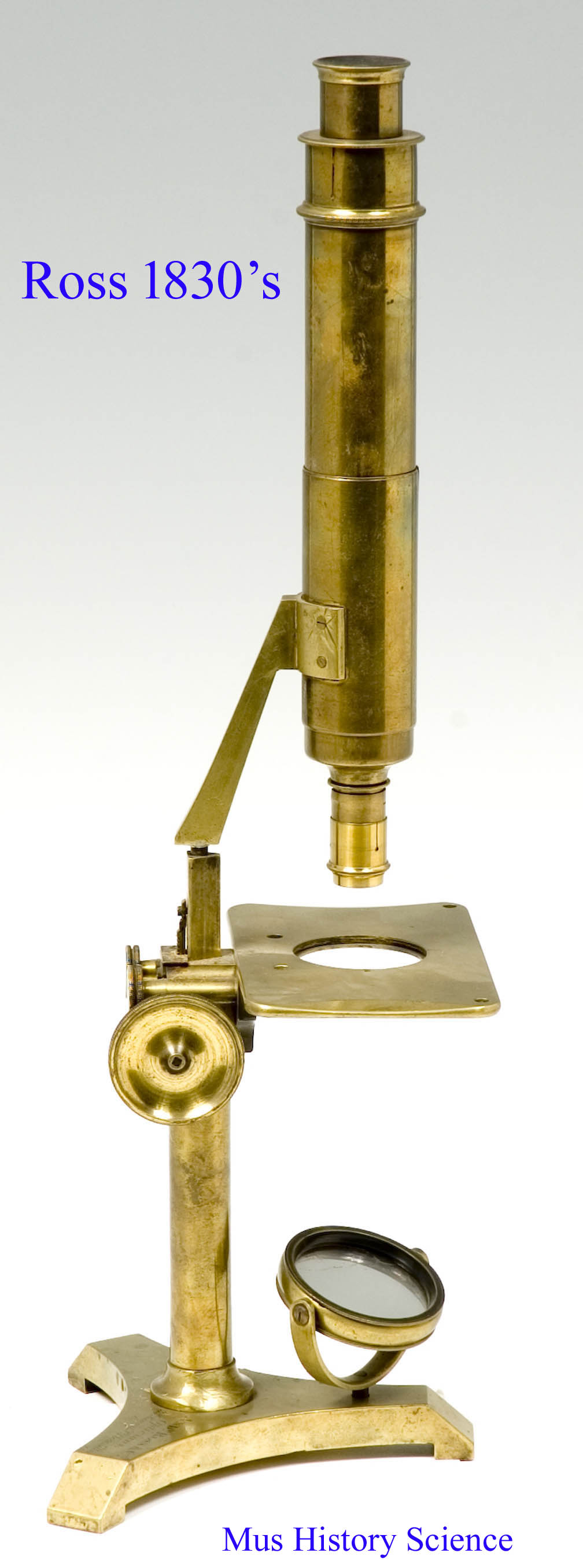
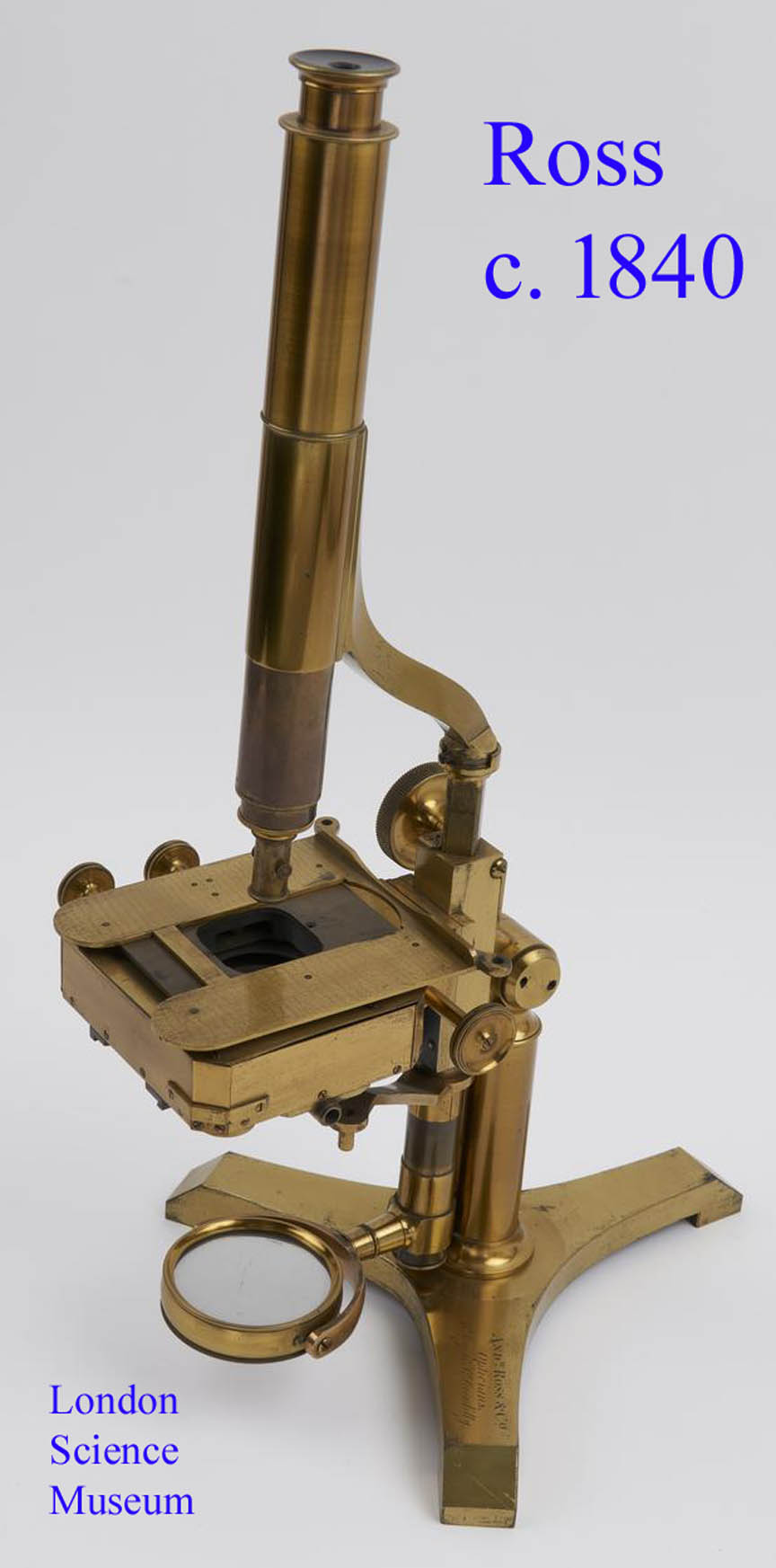 The Watkins optical business was begun by Francis Watkins in 1747. Born in 1723, he had been apprenticed to Nathaniel Adams and Edward Scarlett, and made substantial
improvements to the design of microscopes. He developed a lightweight, tripod mounted microscope, which could be inclined at a comfortable working position. In 1784,
2 sons of his eldest brother, Jeremiah and Walter Watkins took over the business prior to Francis's death in 1791. Jeremiah's second son Francis, born on March 16, 1796
would inherit the optical business and formed a partnership with William Hill, their former foreman in 1817-18. Francis Watkins and Willian Hill both died in 1847,
when the business was continued by Mary Ann Watkins until 1856, selling mostly microscopes bought in from wholesale manufacturers. A full history of the Watkins optical business and their successors can be found on Brian Stevenson's website microscopist.com.
This particular microscope was retailed by Watkins & Hill after the coronation of Queen Victoria in 1837, as per the mention of her Royal patronage on the trade label.
Although it is uncertain, as to whether Watkins & Hill were the manufacturers of this instrument, or parts of it, there are a number of features to suggest, that it was
sourced from
The Watkins optical business was begun by Francis Watkins in 1747. Born in 1723, he had been apprenticed to Nathaniel Adams and Edward Scarlett, and made substantial
improvements to the design of microscopes. He developed a lightweight, tripod mounted microscope, which could be inclined at a comfortable working position. In 1784,
2 sons of his eldest brother, Jeremiah and Walter Watkins took over the business prior to Francis's death in 1791. Jeremiah's second son Francis, born on March 16, 1796
would inherit the optical business and formed a partnership with William Hill, their former foreman in 1817-18. Francis Watkins and Willian Hill both died in 1847,
when the business was continued by Mary Ann Watkins until 1856, selling mostly microscopes bought in from wholesale manufacturers. A full history of the Watkins optical business and their successors can be found on Brian Stevenson's website microscopist.com.
This particular microscope was retailed by Watkins & Hill after the coronation of Queen Victoria in 1837, as per the mention of her Royal patronage on the trade label.
Although it is uncertain, as to whether Watkins & Hill were the manufacturers of this instrument, or parts of it, there are a number of features to suggest, that it was
sourced from the tradeas it existed at the time. Microscope makers such as Hugh Powell, Andrew Ross, James Smith and Andrew Pritchard were at that stage still producing unsigned microscopes, which were subsequently sold by other retailing opticians, and this particular example has a number of features to also suggest this. The nicely constructed Bonanni stage with 2 separate pressure plates is almost identical to one which is part of Pritchard's
Massive modelmicroscope elsewhere on this site. The distinctive double arm connecting the limb with the optical tube on this instrument is highly reminiscent of early examples of Andrew Ross microscopes, notably the one made for William Valentine in 1831 (upper left), and successive models, examples of which are in the MHS and Science Museum collections as shown here(lower left and lower right). Another more massive example of a Ross microscope featuring a similar double support arm is in the Billings collection, and can be dated to 1840 and is shown here to the upper right. The capstans attached to the sleeve holding the mirror also feature on Pritchard and Ross instruments, while Ross also used an internal thread as on this example for his objectives.It is therefore tempting to speculate, that Andrew Ross may have been the maker of this microscope during this same period, before he abandoned his practice of making microscopes for the trade, and then started signing his own instruments.